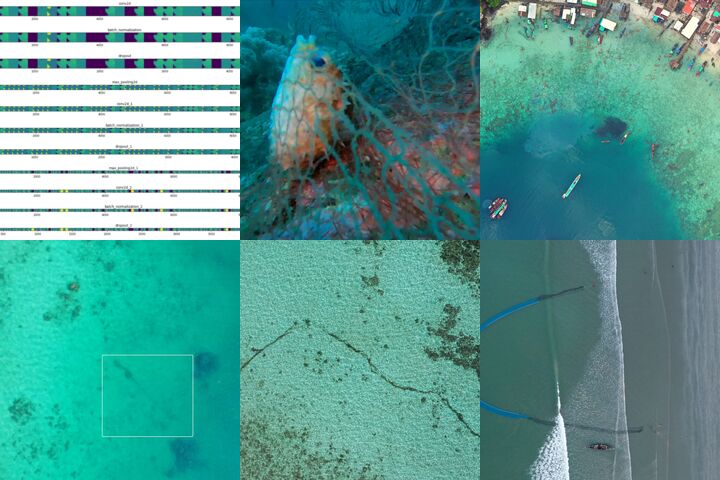Ghost Gear Locator
The Problem
This the 'other'marine plastics issue. Ghost nets are responsible for the deaths of millions of individual marine animals each year, and the destruction of countless marine ecosystems, including reefs and seamounts. To illustrate how ubiquitous this issue is in marine environments, 70% of the total weight of marine macroplastics are speculated to be fishing-related, with an estimated 640'000 tons of gear being added per year. 92% of encounters with ghost gear by marine animals are expected to be lethal, not only due to entanglement, but also due to ingestion of plastic material. This threat is not only damaging to marine ecosystems but also to coastal communities that depend on fishing, as entanglements around fishing grounds reduce the available catch and slow fish stock regeneration. Due to this issue being largely out of sight, the full impact of this form of pollution has been difficult to quantify. Tightening of restrictions around correct disposal of fishing gear has aided in the reduction of the amount gear that is disposed of improperly, or left unretrieved after losses during storm events, however the longevity of these plastics allow the effect of 'ghost fishing' to persist for many years, as nylon-based plastics can take more than a thousand years to fully degrade. This problem is hard to quantify because the issue is mostly out of sight, unless material is washed up or identified during scuba diving or ROV surveys.
Our Proposal
This project aims to use aerial surveying by UAV to create maps of shallow coastal environments, identify all visible ghost gear using Deep learning & computer vision to locate point sources of this pollution. Rapid UAV surveys using a 20MP camera can create high-resolution maps of shallow coastal environments in order to locate this gear. The identification of ghost gear can be conducted manually, by individual observers however this process is very time consuming and not cost-effective for large areas. By training, a deep learning model based on these images. The implication here is that the network will be trained to identify nets present in shallow water but can be adjusted to identify gear in deeper water that human observers may miss. Following training on RGB imagery, the methods can extend to data from multispectral surveys. There are many forms of ghost gear and this process requires large amounts of data for accurate identification, therefore data-sharing with other marine surveying groups will be essential. Once the model is developed and tested on new images, it will be used to provide data for identifying point sources of gear using computer vision. Nets will be physically removed where possible.
We Assume that...
The locations of nets is relevant to tracking their source locally, as a disconnect between net locations & source may obfuscate modelling results.
Local groups will respond to and act on information provided about the issue, particularly when specific fishing operators are identified.
Visible nets are still entangling wildlife.
This will stimulate a change in behaviour among the fishing community.
Constraints to Overcome
Computing power may be an issue, as constructing a deep learning model based on high-resolution images requires a lot of power, therefore sourcing time on a super-computing cluster will be very handy for initial network creation. Gaining UAV surveying permission is difficult and will likely be the biggest obstacle in this process. Attack by birds of prey (sea eagles particularly) has been a big issue & my evasive manoeuvring skill has improved as a result, but a non-harmful method dissuasion would be very useful for future surveys. Aerial surveys are limited by depth & opacity of the water; therefore, we can collect data only as deep as the camera can detect shapes. Expanding to cameras that can detect a wider spectrum than RGB may push the limit of observable gear.
Current Work
The first step will be to find the version of the model that is most effective for identifying ghost gear within images of varying quality. Creating links with marine conservation organisations for testing and collaboration. Conducting interviews with these groups about the specific issues being faced as a result of local ghost fishing and determining how this application can address some of these issues. Determining which UAV design is optimal for large scale surveys- testing in field. Testing raptor-dissuasion techniques for safe flying without loss of UAV and harming of wildlife. Writing grants for funding to test in more field sites, purchasing of equipment and fieldwork costs. Validating model on new datasets and algorithm-generated images. Determining if different classes of ghost gear need separate neural networks.
Current Needs
UAV design will become an increasingly important aspect of the project once the machine learning algorithm has been validated. At this point the ability to fly at low altitude (50 m) at around 6m/s will be very useful therefore a vertical take off and landing (VTOL) fixed-wing design will be vital to gathering information at large spatial scales, during ideal light conditions in the early morning. The capacity to design, build & test new UAV designs will therefore be very useful. Sufficient Cloud-based computer storage will be very important for the security of data collected in the field. Developing connections at a local level and exploring potential to publish results in scientific journal. Identifying roles within organisation and determining if more staff is needed.
